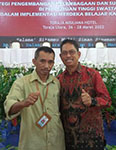Akuatikisle: Jurnal Akuakultur, Pesisir dan Pulau-Pulau Kecil
Full Length Article
Utilization of tempe dregs for the growth of tilapia fish (Oreochromis niloticus)
Highlights
Generate NLP AI by Wizdam ID.
Abstract
The objective of this study is to determine the impact of feeding tempeh dregs at varying doses on tilapia growth and survival (Oreochromis niloticus). The study was conducted from March to May 2023 in Wataliku Village, Kabangka District, Muna Regency. The study employed a completely randomized design with four treatments that involved the administration of tempeh dregs in the diet. These were designated as follows: treatment A (control) was commercial feed; treatment B was 10% tempeh dregs; treatment C was 15% tempeh dregs; and treatment D was 20% tempeh dregs. Each treatment was replicated three times. The data were subjected to analysis of variance (ANOVA) at a confidence level of 95% (α0.05). The study results demonstrated that the highest specific growth was observed with the addition of 20% tempe dregs, with an average of 2.97% per day. This was followed by 15% tempe dregs (2.47% per day), 10% tempe dregs (2.28% per day), and commercial feed (2.00% per day). The highest absolute growth was observed in the treatment that included 20% tempe dregs, with an average of 1.04 g per individual. This was followed by the treatment that included 15% tempe dregs (0.87 g per individual), the treatment that included 10% tempe dregs (0.80 g per individual), and the treatment that included commercial feed (0.00 g per individual). It should be noted that survival was 100% in all treatments. Analysis of variance (α0.05) demonstrated that administration of tempe dregs at varying doses had a statistically significant impact on the specific and absolute growth of tilapia larvae (Oreochromis niloticus).
Keywords
Introduction
Section snippets
Material and Methods
Materials and methods from the full-text PDF of this article cannot be displayed.
Results
Results from the full-text PDF of this article cannot be displayed.
Discussion
Discussion from the full-text PDF of this article cannot be displayed.
Conclusions
Conclusions from the full-text PDF of this article cannot be displayed.
Acknowledgment
Acknowledgment from the full-text PDF of this article cannot be displayed.
Competing interest
The authors declare that they have no known competing financial interests or personal relationships that could have appeared to influence the work reported in this paper.
Conflict of interest
The authors declare that the research was conducted in the absence of any commercial or financial relationships that could be construed as a potential conflict of interest.
Ethical approval acknowledgements
No ethical approval required for this article. All procedures followed were in accordance with the ethical standards of the responsible committee on human experimentation (institutional and national) and with the Helsinki Declaration of 1975, as revised in 2008 (5)
Supplementary files
Data sharing not applicable to this article as no datasets were generated or analysed during the current study, and/or contains supplementary material, which is available to authorized users.
Bibliographic Information
Cite this article as:
-
Submitted
12 June 2024 -
Revised
22 July 2024 -
Accepted
27 July 2024 -
Published
30 July 2024 -
Version of record
15 December 2024 -
Issue date
30 November 2024
-
Academic subject
Aquaculture; Fisheries Science
Keywords
Copyright
Copyright © 2024 Julham Maulit, Abdul Rakhfid, Rochmady, Budiyanti, Karyawati. Sangia Research Media and Publishing. Production and hosting by Sangia (SRM™).  This work is licensed under a Creative Commons Attribution-ShareAlike 4.0 International License.
This work is licensed under a Creative Commons Attribution-ShareAlike 4.0 International License.
Disclaimer: All claims expressed in this article are solely those of the authors and do not necessarily represent those of their affiliated organizations, or those of the publisher, the editors and the reviewers. Any product that may be evaluated in this article or claim that may be made by its manufacturer is not guaranteed or endorsed by the publisher.




